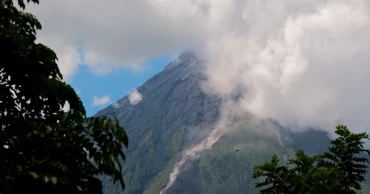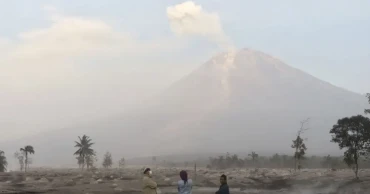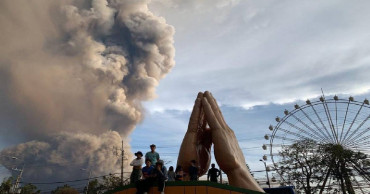Eruption
Philippines’ Mayon Volcano spews lava down its slopes in gentle eruption putting thousands on alert
The Philippines' most active volcano was gently spewing lava down its slopes Monday, alerting tens of thousands of people they may have to quickly flee a violent and life-threatening explosion.
More than 12,600 people have left the mostly poor farming communities within a 6-kilometer (3.7-mile) radius of Mayon Volcano's crater in mandatory evacuations since volcanic activity increased last week. But thousands more remain within the permanent danger zone below Mayon, an area long declared off-limits to people but where generations have lived and farmed because they have nowhere else to go.
With the volcano beginning to expel lava Sunday night, the high-risk zone around Mayon may be expanded should the eruption turn violent, said Teresito Bacolcol, director of the Philippine Institute of Volcanology and Seismology. Bacolcol said if that happens, people in any expanded danger zone should be prepared to evacuate to emergency shelters.
Also Read: Philippines evacuates people near Mayon Volcano, where more unrest indicates eruption may be coming
2 years ago
Philippines evacuates people near Mayon Volcano, where more unrest indicates eruption may be coming
Philippine troops, police and rescue workers began forcibly evacuating residents near Mayon Volcano on Friday as its increasing unrest indicated a violent eruption of one of the country's most active volcanoes is possible within weeks or days.
The area within a 6-kilometer (3.7-mile) radius of Mayon's crater is supposed to be off-limits due to possible volcanic emissions, lava flows, rockfalls and other hazards. But many poor villagers have built houses and tended farms in Mayon's danger zone over the years.
President Ferdinand Marcos Jr. said an evacuation of residents from the permanent danger zone was underway and promised to provide aid to the displaced until the crisis ended.
Also Read: Philippines warns of possible flooding, landslides as Typhoon Mawar slowly passes to north
"Right now, what we are doing is preparing and moving people away from the area so that, should the time come, I hope it doesn't happen…we're ready," Marcos told reporters. "But unfortunately science tells us that may happen because the lid or the cap on top of the lava is slowly rising."
Authorities had raised the alert level for the volcano in northeastern Albay province Thursday after superheated streams of gas, debris and rocks cascaded down its upper slope, indicating activity below the surface that could precede a hazardous eruption.
Conditions have advanced a little bit more Friday, although lava hasn't started to flow, Marcos said.
The numbers of residents being evacuated weren't immediately available.
A tourist draw for its picturesque conical shape, 2,462-meter (8,077-feet) Mayon last erupted violently in 2018, displacing tens of thousands of villagers.
Government volcano experts raised the alert level around Mayon to the third of a five-step warning system Thursday after detecting an increasing number of rockfalls and at least two volcanic earthquakes in recent days.
Six brief volcanic gas and ash emissions streamed down the volcano's southern gullies about 2 kilometers (1.2 miles) from the crater Friday. Numerous rockfalls and thin ash and steam plumes that drifted south were also observed, the government volcanology institute said.
Mayon is at "a relatively high level of unrest as magma is at the crater and hazardous eruption is possible within weeks or even days," the institute said in its latest update Friday morning.
Mayon is one of the most restive of two dozen active volcanoes across the Philippines.
Officials also were closely monitoring Taal Volcano south of Manila and Mount Kanlaon on central Negros island due to renewed signs of restiveness.
A number of villages in three towns near Taal suspended classes Wednesday due to thick smog emanating from the volcano and residents were advised to limit outdoor activities and wear masks for protection.
The Philippines lies along the Pacific "Ring of Fire," the area around the ocean rim where tectonic plates meet that is prone to earthquakes and volcanic eruptions. A long-dormant volcano, Mount Pinatubo, blew its top north of Manila in 1991 in one of the biggest volcanic eruptions of the 20th century, killing hundreds of people.
2 years ago
Indonesia’s Merapi volcano spews hot clouds in new eruption
Indonesia’s Mount Merapi erupted Saturday with avalanches of searing gas clouds and lava, forcing authorities to halt tourism and mining activities on the slopes of the country’s most active volcano.
Merapi, on the densely populated island of Java, unleashed clouds of hot ash and a mixture of rock, lava and gas that traveled up to 7 kilometers (4.3 miles) down its slopes. A column of hot clouds rose 100 meters (yards) into the air, said the National Disaster Management Agency’s spokesperson Abdul Muhari.
The eruption throughout the day blocked out the sun and blanketed several villages with falling ash. No casualties have been reported.
It was Merapi’s biggest lava flow since authorities raised the alert level to the second-highest in November 2020, said Hanik Humaida, the head of Yogyakarta’s Volcanology and Geological Hazard Mitigation Center.
Also Read: Indonesia landslide deaths climb to 21; dozens still missing
She said residents living on Merapi’s slopes were advised to stay 7 kilometers (4.3 miles) away from the crater’s mouth and be aware of the danger posed by lava.
Tourism and mining activities were halted.
The 2,968-meter (9,737-foot) mountain is about 30 kilometers (18 miles) from Yogyakarta, an ancient center of Javanese culture and the seat of royal dynasties going back centuries. About a quarter million people live within 10 kilometers (6 miles) of the volcano.
Merapi is the most active of more than 120 active volcanoes in Indonesia and has repeatedly erupted with lava and gas clouds recently. Its last major eruption in 2010 killed 347 people and displaced 20,000 villagers.
Also Read: Indonesia fuel depot fire kills 19; 3 still missing
Indonesia, an archipelago of 270 million people, is prone to earthquakes and volcanic activity because it sits along the “Ring of Fire,” a horseshoe-shaped series of seismic fault lines around the Pacific Ocean.
An eruption in December 2021 of Mount Semeru, the highest volcano on Java island, left 48 people dead and 36 missing.
2 years ago
Indonesia's Mt. Semeru eruption buries homes, damages bridge
Improved weather conditions Monday allowed rescuers to resume evacuation efforts and a search for possible victims after the highest volcano on Indonesia’s most densely populated island erupted, triggered by monsoon rains.
Mount Semeru in Lumajang district in East Java province spewed thick columns of ash more than 1,500 meters (nearly 5,000 feet) into the sky Sunday. Villages and nearby towns were blanketed with falling ash, blocking out the sun, but no casualties have been reported.
Read more: Strong quake shakes main Indonesia island; no tsunami alert
Hundreds of rescuers were deployed Monday in the worst-hit villages of Sumberwuluh and Supiturang, where houses and mosques were buried to their rooftops by tons of volcanic debris.
Heavy rains had eroded and finally collapsed the lava dome atop the 3,676-meter (12,060-foot) volcano, causing an avalanche of blistering gas and lava down its slopes toward a nearby river. Searing gas raced down the sides of the mountain, smothering entire villages and destroying a bridge that had just been rebuilt after a powerful eruption last year.
Semeru’s last major eruption was in December 2021, when it blew up with a fury that left 51 people dead in villages that were buried in layers of mud. Several hundred others suffered serious burns and the eruption forced the evacuation of more than 10,000 people. The government moved about 2,970 houses out of the danger zone, including from Sumberwuluh village.
Lumajang district chief Thoriqul Haq said villagers who are still haunted by last year's eruption fled on their own when they heard the mountain start to rumble early Sunday, so that “casualties could be avoided.”
“They have learned an important lesson on how to avoid the danger of eruption,” he said while inspecting a damaged bridge in Kajar Kuning hamlet.
He said nearly 2,000 people escaped to emergency shelters at several schools, but many were returned to their homes Monday to tend their livestock and protect their property.
Increased volcanic activity Sunday afternoon prompted authorities to widen the danger zone to 8 kilometers (5 miles) from the crater, and scientists raised the volcano’s alert level to the highest, said Hendra Gunawan, who heads the Volcanology and Geological Hazard Mitigation Center.
People were advised to keep off the southeastern sector along the Besuk Kobokan River, which is in the path of the lava flow.
Read more: Death toll from Indonesia earthquake reaches 310 as more bodies found
Semeru, also known as Mahameru, has erupted numerous times in the past 200 years. Still, as is the case with many of the 129 active volcanoes in Indonesia, tens of thousands of people continue to live on its fertile slopes.
Indonesia, an archipelago of more than 270 million people, sits along the Pacific “Ring of Fire,” a horseshoe-shaped series of fault lines, and is prone to earthquakes and volcanic activity.
3 years ago
World’s largest active volcano Mauna Loa erupts in Hawaii
The world’s largest active volcano was erupting Monday and wasn’t immediately threatening communities on Hawaii’s Big Island, but officials warned residents to be ready for worse.
Many current residents weren’t living there when Mauna Loa last erupted 38 years ago. The U.S. Geological Survey warned the roughly 200,000 people on the Big Island that an eruption “can be very dynamic, and the location and advance of lava flows can change rapidly.”
The eruption began late Sunday night following a series of fairly large earthquakes, said Ken Hon, the scientist-in-charge at the Hawaiian Volcano Observatory.
There’s been a surge of development on the Big Island in recent decades — its population has more than doubled, from 92,000 in 1980.
Most of the people on the island live in the city of Kailua-Kona to the west of the volcano, which has about 23,000 people, and Hilo to the east, with about 45,000. Officials were most worried about several subdivisions about 30 miles to the south of the volcano, which are home to about 5,000 people.
A time-lapse video of the eruption from overnight showed lava lighting up one area, moving across it like waves on the ocean.
The U.S. Geological Survey said that the eruption had migrated to a rift zone — a place where the mountain rock is cracked and relatively weak — making it easier for magma to emerge.
An eruption from the zone could send lava toward the county seat of Hilo or other towns in East Hawaii but it could take the lava weeks or months to reach populated areas.
“We don’t want to try and second-guess the volcano,” Hon said. “We have to let it actually show us what it’s going to do and then we inform people of what is happening ASAP.”
Hawaii County Civil Defense announced that it had opened shelters because it had reports of people evacuating from along the coast on their own initiative.
The average Mauna Loa eruption is not typically prolonged, lasting a couple of weeks, Hon said.
“Typically, Mauna Loa eruptions start off with the heaviest volume first,” Hon said. “After a few days, it starts to calm down a little bit.”
The USGS warned residents at risk from Mauna Loa lava flows to review their eruption preparations. Scientists had been on alert because of a recent spike in earthquakes at the summit of the volcano, which last erupted in 1984.
Portions of the Big Island were under an ashfall advisory issued by the National Weather Service in Honolulu, which said up to a quarter-inch (0.6 centimeters) of ash could accumulate in some areas.
Mauna Loa is one of five volcanoes that together make up the Big Island of Hawaii, which is the southernmost island in the Hawaiian archipelago.
Mauna Loa, rising 13,679 feet (4,169 meters) above sea level, is the much larger neighbor of Kilauea, which erupted in a residential neighborhood and destroyed 700 homes in 2018. Some of its slopes are much steeper than Kilauea’s, so lava can flow much faster when it erupts.
During a 1950 eruption, the mountain’s lava traveled 15 miles (24 kilometers) to the ocean in fewer than three hours.
Tourism is Hawaii’s economic engine but Roth predicted few problems for those on vacation during the eruption.
“It will be spectacular where it is, but the chances of it really interrupting the visitor industry — very, very slim,” he said.
For some, the eruption might cut down on some travel time, even if there is more volcanic smog caused by higher sulfur-dioxide emissions.
Read more: Hawaii's Kilauea volcano erupts, lava fountains form in park
“But the good thing is you don’t have to drive from Kona over to Hawaii Volcanoes National Park to see an eruption anymore,” Roth said. “You can just look out your window at night and you’ll be able to see Mauna Loa erupting.”
Julia Neal, owner of Pahala Plantation Cottages, said the eruption brings some relief after many preparedness meetings, and much wondering about what the volcano will do.
“It’s exciting,” she said. “It’s kind of a relief that it’s happening and we’re not waiting for it to happen.”
A few future guests from the U.S. mainland called Neal “asking me to make a prediction, which I can’t,” she said. “So I said, just stand by.”
Read more: Philippine volcano makes phreatic eruption anew within one week
3 years ago
Tsunami threat recedes from huge Pacific volcanic eruption
The tsunami threat around the Pacific from a huge undersea volcanic eruption began to recede Sunday, while the extent of damage to Tonga remained unclear.
Satellite images showed the spectacular eruption that took place Saturday evening, with a plume of ash, steam and gas rising like a mushroom above the blue Pacific waters. A sonic boom could be heard as far away as Alaska.
In nearby Tonga it sent tsunami waves crashing across the shore and people rushing to higher ground.
READ: Strong quake shakes Indonesia’s capital; no tsunami alert
The eruption cut the internet to Tonga, leaving friends and family members around the world still anxiously trying to get in touch to figure out if there were any injuries and the extent of the damage. Even government websites and other official sources remained without updates.
Aid agencies said thick ash and smoke was continuing to affect Tonga's air and water, and that authorities were asking people to wear masks and drink bottled water.
Dave Snider, the tsunami warning coordinator for the National Tsunami Warning Center in Palmer, Alaska, said it was very unusual for a volcanic eruption to affect an entire ocean basin, and the spectacle was both “humbling and scary.”
The tsunami waves caused damage to boats as far away as New Zealand and Santa Cruz, California, but did not appear to cause any widespread damage. Snider said he anticipated the tsunami situation in the U.S. and elsewhere to continue improving.
Tsunami advisories were earlier issued for Japan, Hawaii, Alaska and the U.S. Pacific coast. The U.S. Geological Survey estimated the eruption caused the equivalent of a magnitude 5.8 earthquake. Scientists said tsunamis generated by volcanoes rather than earthquakes are relatively rare.
The Tonga Meteorological Services said a tsunami warning was declared for all of the archipelago, and data from the Pacific tsunami center said waves of 80 centimeters (2.7 feet) were detected.
Rachel Afeaki-Taumoepeau, who chairs the New Zealand Tonga Business Council, said she hoped the relatively low level of the tsunami waves would have allowed most people to get to safety, although she worried about those living on islands closest to the volcano. She said she hadn't yet been able to contact her friends and family in Tonga.
“We are praying that the damage is just to infrastructure and people were able to get to higher land,” she said.
Tonga gets its internet via an undersea cable from Suva, Fiji, which presumably was damaged. All internet connectivity with Tonga was lost at about 6:40 p.m. local time, said Doug Madory, director of internet analysis for the network intelligence firm Kentik.
The Fiji-based Islands Business news site reported that a convoy of police and military troops evacuated Tonga's King Tupou VI from his palace near the shore. He was among the many residents who headed for higher ground.
On Tonga, home to about 105,000 people, video posted to social media showed large waves washing ashore in coastal areas and swirling around homes, a church and other buildings.
New Zealand's military said it was monitoring the situation and remained on standby, ready to assist if asked.
READ: Indonesia quake kills 7 in Java, jolts Bali; no tsunami risk
In Hawaii, the Pacific Tsunami Warning Center reported waves that measured half a meter (1.6 feet) in Nawiliwili, Kauai and 80 centimeters (2.7 feet) in Hanalei.
In Tonga, a Twitter user identified as Dr. Faka’iloatonga Taumoefolau posted video showing waves crashing ashore.
“Can literally hear the volcano eruption, sounds pretty violent,” he wrote, adding in a later post: “Raining ash and tiny pebbles, darkness blanketing the sky.”
The explosion of the Hunga Tonga Hunga Ha’apai volcano was the latest in a series of dramatic eruptions.
Earth imaging company Planet Labs PBC had watched the island in recent days after a new volcanic vent there began erupting in late December.
Satellite images captured by the company show how drastically the volcano had shaped the area, creating a growing island off Tonga.
“The surface area of the island appears to have expanded by nearly 45% due to ashfall,” Planet Labs said days before the latest activity.
Following Saturday's eruption, residents in Hawaii, Alaska and along the U.S. Pacific coast were advised to move away from the coastline to higher ground and to pay attention to specific instructions from their local emergency management officials, said Snider.
“We don’t issue an advisory for this length of coastline as we’ve done - I’m not sure when the last time was - but it really isn’t an everyday experience,” Snider said.
Savannah Peterson watched in shock as the water rose several feet in a matter of minutes in front of her oceanfront house in Pacifica, California, just south of San Francisco.
“It came up so fast, and a few minutes after that it was down again. It was nuts to see that happen so quickly,” she said. “I’ve never had water come all the way up to my front door, and today it did.”
Police rescued a surfer whose surfboard broke in powerful waves off San Francisco.
Farther south in Santa Cruz, California, officials were taking stock of damage after a surge damaged boats and inundated low-lying streets and parking lots, sending cars afloat.
In Southern California, surging waters sunk at least one boat in Ventura Harbor northwest of Los Angeles.
New Zealand’s private forecaster, Weather Watch, tweeted that people as far away as Southland, the country’s southernmost region, reported hearing sonic booms from the eruption. Others reported that many boats were damaged by a tsunami that hit a marina in Whangarei, in the Northland region.
Earlier, the Matangi Tonga news site reported that scientists observed massive explosions, thunder and lightning near the volcano after it started erupting early Friday. Satellite images showed a 5-kilometer (3-mile) -wide plume rising into the air to about 20 kilometers (12 miles).
The Hunga Tonga Hunga Ha’apai volcano is located about 64 kilometers (40 miles) north of the capital, Nuku’alofa. In late 2014 and early 2015, a series of eruptions in the area created a small new island and disrupted international air travel to the Pacific archipelago for several days.
There is not a significant difference between volcanoes underwater and on land, and underwater volcanoes become bigger as they erupt, at some point usually breaching the surface, said Hans Schwaiger, a research geophysicist with the Alaska Volcano Observatory.
With underwater volcanoes, however, the water can add to the explosivity of the eruption as it hits the lava, Schwaiger added.
Before an explosion, there is generally an increase in small local earthquakes at the volcano, but depending on how far it is from land, that may not be felt by residents along the shoreline, Schwaiger said.
In 2019, Tonga lost internet access for nearly two weeks when a fiber-optic cable was severed. The director of the local cable company said at the time that a large ship may have cut the cable by dragging an anchor. Until limited satellite access was restored people couldn’t even make international calls.
Southern Cross Cable Network's Veverka said limited satellite connections exist between Tonga and other parts of the world but he did not know if they might be affected by power outages.
3 years ago
Volcano erupts near Manila; airport shut, villagers flee
A small volcano south of the Philippine capital that draws many tourists for its picturesque setting in a lake erupted with a massive plume of ash and steam Sunday, prompting thousands of people to flee and officials to shut Manila's international airport.
5 years ago
Tiny Philippine volcano ejects smoke and ash, villagers flee
A tiny Philippine volcano that draws many tourists because of its picturesque setting amid a lake belched steam, ash and small rocks Sunday, prompting residents to flee from nearby villages and authorities to raise the danger level.
5 years ago














